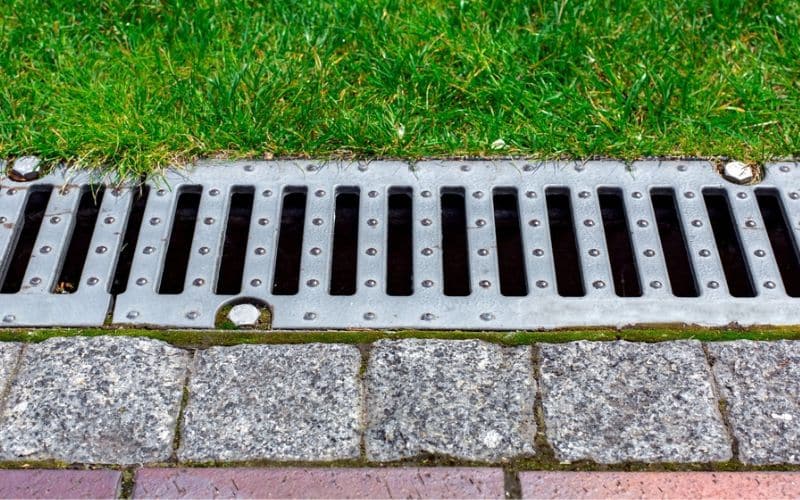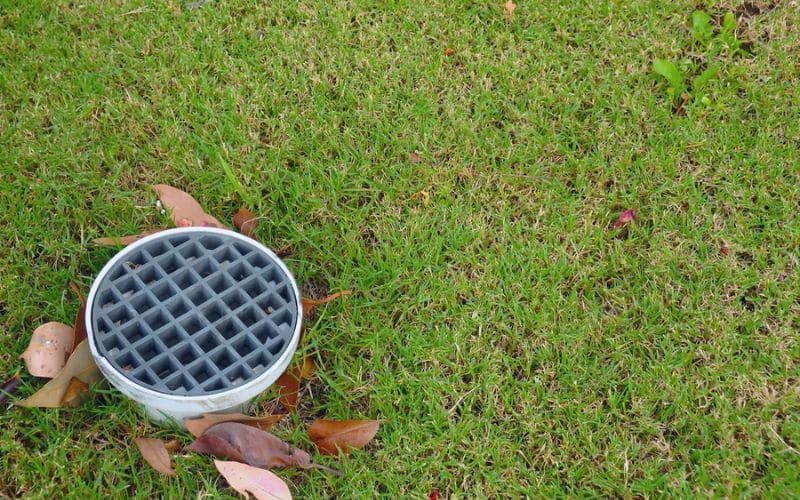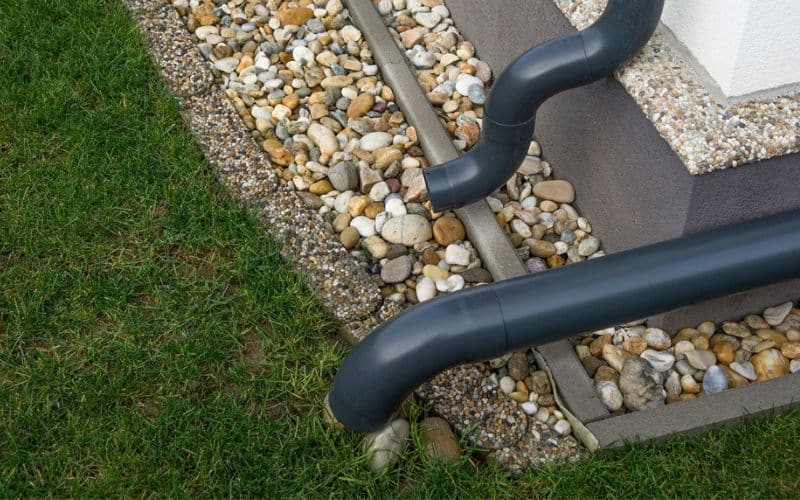
During the wet months, gardeners often feel disappointed as their back gardens transform into swamps, causing long-term effects due to the necessity of good drainage for growing various garden plants and maintaining healthy grass. Additionally, standing water on landscaping features, such as decking and paving, can result in damage, significantly reducing their lifespan and increasing the need for more frequent maintenance.
Yard drains are crucial not only for keeping your yard dry but also for maintaining the overall condition of your house. They are also a safety hazard, as nobody wants to slip while enjoying their outdoor living space.
Common Yard Drainage Problems & Causes
When you encounter a garden with standing water, mushy spots, and a wet basement, you’re probably dealing with a yard drainage issue. Other indicators of such a problem include the soil making squelching noises when stepped on, the growth of reed-like plants in the grass, and the presence of moss.
Standing Water
Have you ever observed water accumulating in your yard following a heavy summer downpour or several days of continuous rain? If this is the case, you likely have a lawn drainage issue. Typically, two primary factors contribute to the presence of standing water: an insufficient lawn gradient and inadequate soil-drainage capacity.
Poor Lawn Slope
If your lawn isn’t adequately graded to handle runoff water, it could result in water-related issues such as standing water or possible leaks into your basement area. Homes located at the base of a slope or hill may be particularly vulnerable to water runoff flowing toward the foundation of the house.
Improperly Installed Gutter & Downspout Runoff
Excess water in your yard can often be attributed to gutters and downspouts, as they may overflow or have leader pipes that do not properly direct water away from the house. This can lead to runoff pooling around the home’s foundation, resulting in issues for both the landscape and the structure itself.
Run Off From Neighbours
Erosion originating from higher elevations poses a significant issue, particularly for those living downhill from other properties. It is not necessarily the fault of your neighbours, and it would be unreasonable to request they stop it. The optimal course of action is to observe the flow of water entering your yard during a downpour.
Landscaping Features
Some features in your landscape may also contribute to water drainage issues in your lawn. For instance, having a pond or a waterfall on your property can redirect water away from your lawn, leading to drainage problems.

What Happens When You Had A Poor Yard Drainage?
Yard drainage plays a crucial role in gardening and agricultural practices globally. Poor drainage is not merely a visual problem; it also significantly threatens the well-being of lawn and landscape plants.
Water drainage problems can cause other frustrations and dangers related to standing water, such as:
- Cannot fully appreciate your lawn
- Increased presence of mosquitoes and other insects in standing water.
- Potential for severe damage to your home’s foundation.
- Risk of basement flooding caused by insufficient water drainage.
A property with good drainage has a gentle and gradual slope that descends 6 inches within the first 10 feet around the foundation, followed by an additional foot of slope over the subsequent 100 feet.
Reduce Having A Yard Drainage Issue With These Lawn Drainage Solutions
Perpetually wet soil makes it challenging for the majority of garden plants to thrive. Implement these drainage solutions to either resolve the issue or adapt better to your existing soggy soil conditions.
Rain Garden For Excess Water
A rain garden is an attractive and functional way to handle excess water on your property. This natural, self-sufficient system enables water to gather in a shallow dip, where it can steadily soak into the ground. It is essentially a part of your yard designed to capture water and filled with water-loving plants.
Rain gardens are especially effective in managing water runoff from roofs, driveways, and other impervious surfaces.
To develop a successful rain garden, selecting the proper location and soil mixture is crucial. The garden should be placed in a depression where water naturally pools. The soil combination should allow for good drainage while also retaining moisture during dry spells. Native plants are the ideal choice for a rain garden, as they are well-adapted to the local climate and can flourish in damp environments.
Install Decking
When you install your deck, make sure there is enough space between each board to minimize puddle formation on the surface. Under your deck, use flashing as a moisture barrier, and for maximum protection, implement a drainage system. Look for products that effectively direct water away from the joists, beams, and your home’s exterior. You could use corrugated plastic sheets, but ensure they are watertight.
Alternatively, place a sloping, impenetrable surface under your deck to channel water away from your home in a controlled way.

Extend Your Downspout
When dealing with landscape drainage problems, you might discover the root cause is runoff from your gutter system. To address this issue, try extending the downspout away from your house to prevent the formation of a basin. Just ensure that you direct the extended downspout towards a storm drain or another safe drainage area, avoiding neighbouring properties.
Additionally, confirm that the gutters are functioning correctly, as blocked or malfunctioning gutters can lead to water overflowing and costly damage. If your roof becomes a waterfall during rainstorms, it might be time to address some gutter repairs.
Ensure that your home is equipped with a complete set of appropriately sized gutters and that these gutters connect to downspouts. Make it a point to clean the gutters and downspouts at least two times a year.
Install A Catch Basin
The most detrimental issue when water pours onto the ground from gutters and downspouts is the pooling and absorption near the foundation of your home. To prevent this, install a catch basin at the base of every downspout to direct the water away. A catch basin is primarily an underground container made of polypropylene or masonry with a ground-level grate that enables water to drain into it. Equipped with a drainage pipe, this basin efficiently discharges the accumulated water to a safer distance.
Aerate The lawn
Lawn aeration not only enhances the grass’s well-being but also generates a more penetrable surface that takes in water, contributing to yard drainage. Creating holes in your lawn through aeration breaks up the compacted soil underneath the yard. This yard drainage solution enables air, nutrients, and water to access the grassroots, minimizing runoff.
Complete the task using a specialized lawn aerator, or utilize a pitchfork to create holes in the grass.
Add More Dirt
If your yard has only a few shallow spots that collect water after a rainfall, add soil to these areas. Simply spread topsoil over the low spots and use a rake to mix it in. Additionally, incorporate large amounts of organic matter into your soil, allowing it to absorb necessary water while letting excess moisture pass through unhindered.
Consider whether your yard needs a complete grade correction by placing a level against the soil right next to your home’s foundation. If the yard is graded properly, the ground should slope down about 1 inch for each foot moved away from the house. If this is not the case, add more soil around your home, ensuring it does not touch your siding. At least 4 inches of your concrete foundation should be visible above the soil.
Replace Hardscaping With Paving Materials
A concrete patio serves as a hardscape that elevates you or your vehicle above wet ground and dries out quickly. However, it can sometimes divert water in an undesirable direction. Permeable paving materials offer a solution for managing runoff and excess water, as they not only prevent runoff but also allow water to slowly seep into the soil.
Concrete, asphalt, and plastic pavers with tiny gaps make up these materials, enabling water to pass through and reach the quick-draining gravel layers beneath. Moreover, these materials come in various styles and colours, allowing you to design a functional and attractive outdoor space.
Dig A Creek Bed
A dry creek bed serves as an effective solution to backyard flooding while enhancing the landscape’s appearance. It functions as a drainage channel, redirecting water away from the house. Similarly, a swale is a recessed area that collects water but typically features fewer rocks.
By incorporating plants and potentially a small bridge along the creek bed, one can elevate the visual appeal of these water collection methods.
Build A Dry Well
A dry creek bed is an effective and visually appealing solution to backyard flooding. Made of rocks ranging in size from small river rocks to larger boulders, it serves as a drainage channel that redirects water away from your home, while also leveling up your landscape design. If the ground slope allows, a creek bed can be used to collect water from low-lying areas.
Incorporating plants along the creek bed and adding features like a small bridge can enhance its appearance and create a stunning focal point. In addition to its water management capabilities, a creek bed is a beautiful form of xeriscaping for your yard when not actively collecting water.

Install A French drain
If you encounter a severe drainage issue in your garden, a French drain can be installed as a solution. This yard drainage system consists of an additional underground drain pipe designed to absorb surface water and prevent flooding.
To install a French drain, a trench is dug and can be filled with materials such as gravel, sand, rocks, or even a perforated pipe. Utilizing a pipe is particularly effective in situations with a large amount of water.
Once in place, water flows through the gravel and enters the PVC pipe, efficiently carrying the water away, and resolving the drainage problem.
Fix Any Yard Drainage Issues Now
In summary, without proper drainage, dispersing water becomes difficult and maintaining a healthy, functional outdoor space is nearly impossible. The majority of these yard drainage solutions can be undertaken by homeowners willing to put in some effort.
It is important to examine the issue closely before selecting and executing the appropriate solution. Consulting a professional for assistance in diagnosing and resolving the problem is advisable if you are uncertain about the cause.
Colin Macmillan is a seasoned entrepreneur and the CEO of Riverwood Landscape, a leading landscaping company based in Canada. He has been at the helm of the company since leaving high school, demonstrating his strong leadership skills and business acumen.
Colin’s expertise lies in various aspects of landscaping, including lawn care, interlocking, sod installation, and commercial maintenance. His hands-on approach and dedication to the craft have been instrumental in building Riverwood Landscape into a reputable brand.
One of his most notable achievements is the creation of a successful landscape franchise that services multiple locations. This accomplishment underscores his strategic thinking and ability to scale operations effectively.
Colin has also had the privilege of working with Guelph Hospital for landscaping and maintenance, a testament to the trust and reliability that his company has earned over the years.
His professional mission is to offer the best services and experiences for customers, a goal that he tirelessly pursues. Colin’s commitment to excellence and customer satisfaction continues to drive the growth and success of Riverwood Landscape.








